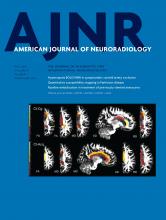We thank Dr Kanda and colleagues for their interest in our article “Gadolinium-Based Contrast Agent Accumulation and Toxicity: An Update”1 and acknowledge them for their contributions to the awareness of gadolinium accumulation in the brain. Below, we will attempt to address their comments and concerns.
At the time our article was written, the study by Stojanov et al2 reported that gadobutrol (Gadavist; Bayer Schering Pharma, Berlin, Germany) caused T1 hyperintensity in the dentate nucleus. Their findings were unexpected and highlighted the need for evaluation of each gadolinium-based contrast agent (GBCA). In fact, after our article was submitted to the American Journal of Neuroradiology, Radbruch et al3 put forward new information regarding gadobutrol deposition in the dentate nucleus. By replicating the work of Stojanov et al, they concluded that no signal-intensity increase was seen with this agent, explaining the lack of it in the image provided by Stojanov et al. More recently, Cao et al4 found that unenhanced high T1 signal hyperintensity was observed in the dentate nucleus after multiple administrations of gadopentetate dimeglumine (Magnevist; Bayer HealthCare Pharmaceuticals, Wayne, New Jersey) but not after multiple administrations of gadobutrol, corroborating the findings of Radbruch et al. As stated in our article, the more stable macrocyclic GBCAs such as gadoteridol (ProHance; Bracco Diagnostics, Princeton, New Jersey) and gadoterate meglumine (Dotarem; Guerbet, Aulnay-sous-Bois, France) are not associated with substantial MR imaging changes, supporting the idea that gadolinium accumulation differs according to the stability of the agent used.5,6
Although the animal study by Jost et al7 demonstrated a lack of association between gadobutrol (Gadavist) and T1 dentate nucleus hyperintensity, we recommend caution with extrapolating data from animal studies to humans. In that study, gadopentetate dimeglumine injection led to a moderately elevated dentate nucleus-to-pons signal-intensity ratio, not statistically significant, which differs from findings in human studies.4⇓–6 Moreover, a more recent animal study performed by Robert et al8 showed that repeated administrations of that agent were associated with progressive and significant T1 hyperintensity in the dentate nucleus.
We remind our readers that no brain MR imaging changes have been noted in human studies after repeated administrations of the more stable GBCAs gadoteridol, gadoterate meglumine, and gadobutrol. Despite the work of Robert et al,8,9 more human studies are needed to definitively exclude deposition of these agents in humans.
Although Dr Kanda claims that his article10 was submitted before the one by McDonald et al,11 the latter was accepted and published first. Like most investigators, we do not have access to articles not yet published. Nevertheless, our article correctly quotes the number of patients studied, the GBCAs given, and the neural structures evaluated in both articles.
Last, we apologize for misciting the statement related to gadolinium deposits in the endothelial wall. As pointed out by Dr. Kanda and colleagues, this sentence is found in the article by McDonald et al11 and not the article by Kanda et al.10
References
- © 2016 by American Journal of Neuroradiology












